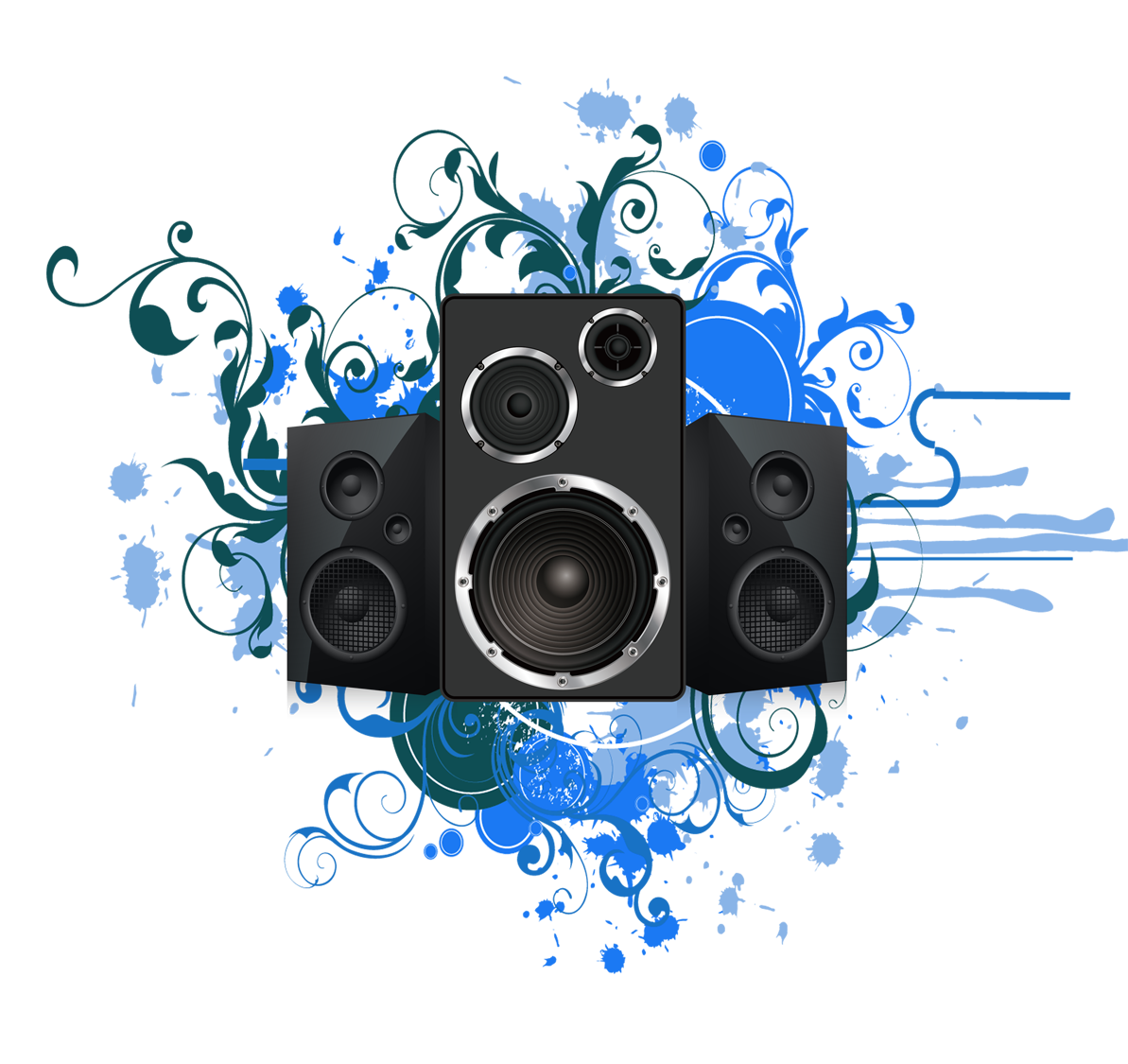Dirac Live LE calibration
Before proceeding with our listening tests, we decided to take advantage of the NAD M10 amp’s compatibility with Dirac technology and carry out an acoustic calibration. Thanks to the included microphone, we were able to benefit from an acoustic correction based on the acoustic characteristics of our room.
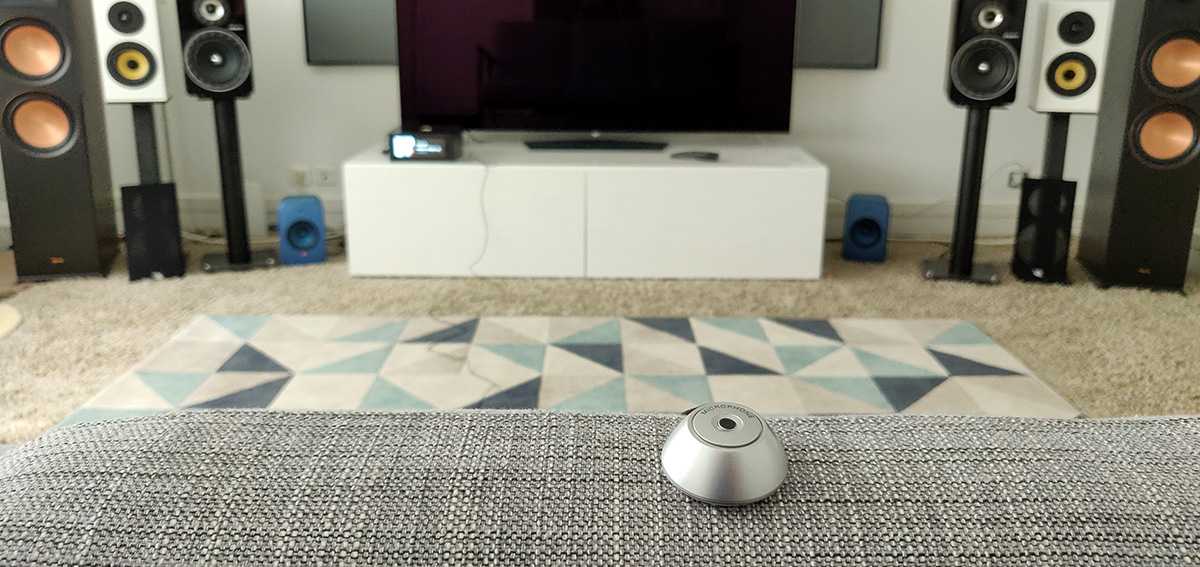
A calibration microphone is included with the NAD M10 amp.
In order to carry out a calibration of the NAD M10, we downloaded the Dirac Live application from the Playstore. Once launched, the app detects the amp and connects to it in a matter of seconds. It then guides the user through the acoustic calibration process.
First, you must determine the listening position (an armchair or a sofa) and specify if you wish to have a targeted or a wide listening area. Then, you have to place the microphone at the location shown in the diagram before setting the volume of the amp to a level that allows the calibration to be performed correctly.
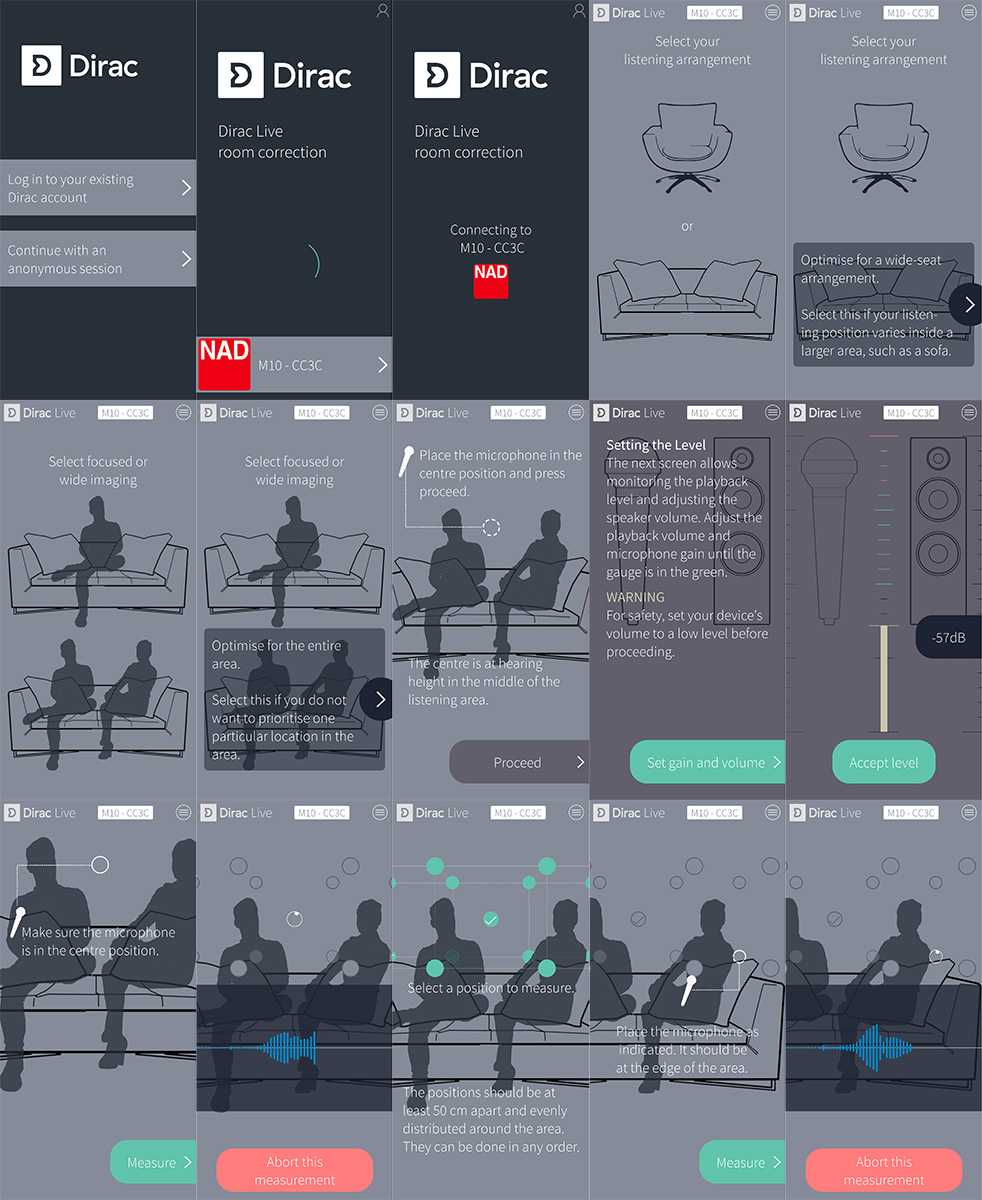
The Dirac Live app guides the user through the steps to carry out the measurements that will be used for the acoustic calibration of the NAD M10 amplifier.
The Dirac Live calibration can then start. The app takes into account multiple measurement points (17 in our case!) to establish a three-dimensional map of the listening area which allows it to accurately optimize the sound restitution based on the acoustic properties of the room. For each of the different measurements, the user must position the microphone at the indicated location. The app then emits a series of sound signals that are analyzed to determine the influence of the listening room and correct any negative effects.
Once these measurements are finished, the application displays the frequency response curve for both channels before correction (in red and green) and the corrected curve (in gold). The suggested correction can then be saved so that it is accessible in the BluOS app.
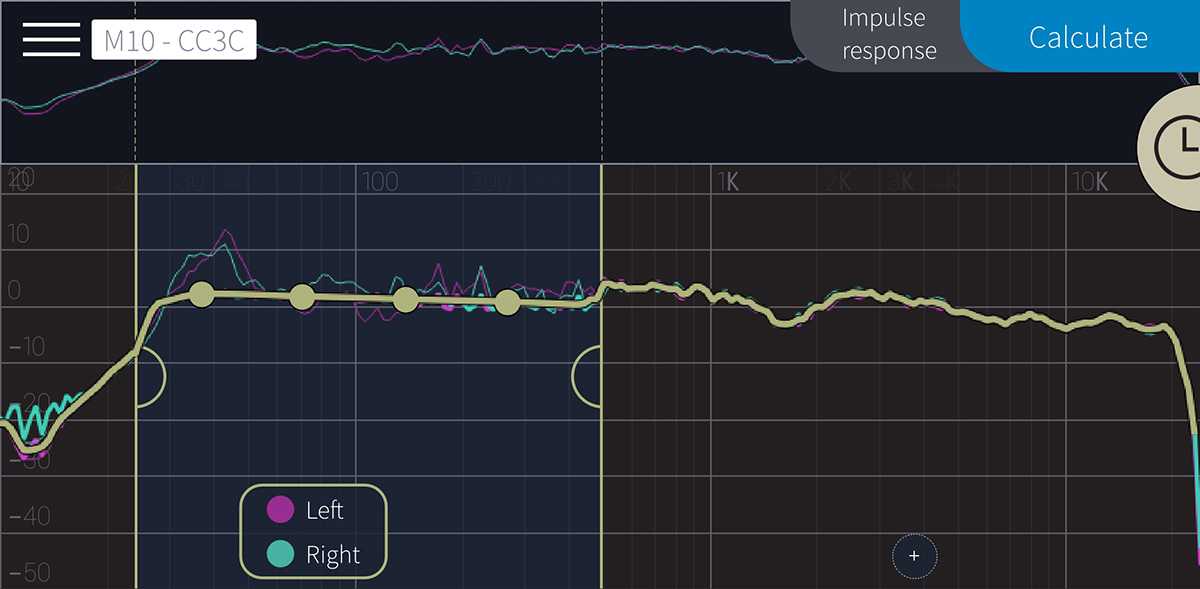
In this graph created with the measurements carried out with the Klipsch RP-8000F speakers, the application highlights the corrected frequency range, here between 20Hz and 500Hz. We can clearly discern the reverberations of our room between 30Hz and 40Hz (green and red spikes), as well as the irregularities between 150Hz and 500Hz. The corrected curve (in gold) is much more linear.
NAD M10: listening impressions
We did most of our review using our reference compact speakers, the Elipson Prestige Facet 8Bs. However, we also carried out a few listening sessions with the Davis Acoustics Courbet N°3 compact speakers and the Klipsch RP-8000F floorstanding speakers. We used the Viard Audio Silver HD12 HP speaker cable mounted with banana plugs.
We used the BluOS app to launch different webradios via TuneIn and listened to Qobuz (Hi-Fi Sublime+ subscription) and Deezer (Family account, streaming in studio quality up to 24 bits/192kHz) online music services. We also tried movie soundtracks with Netflix with our LG OLED TV connected via the HDMI ARC port.
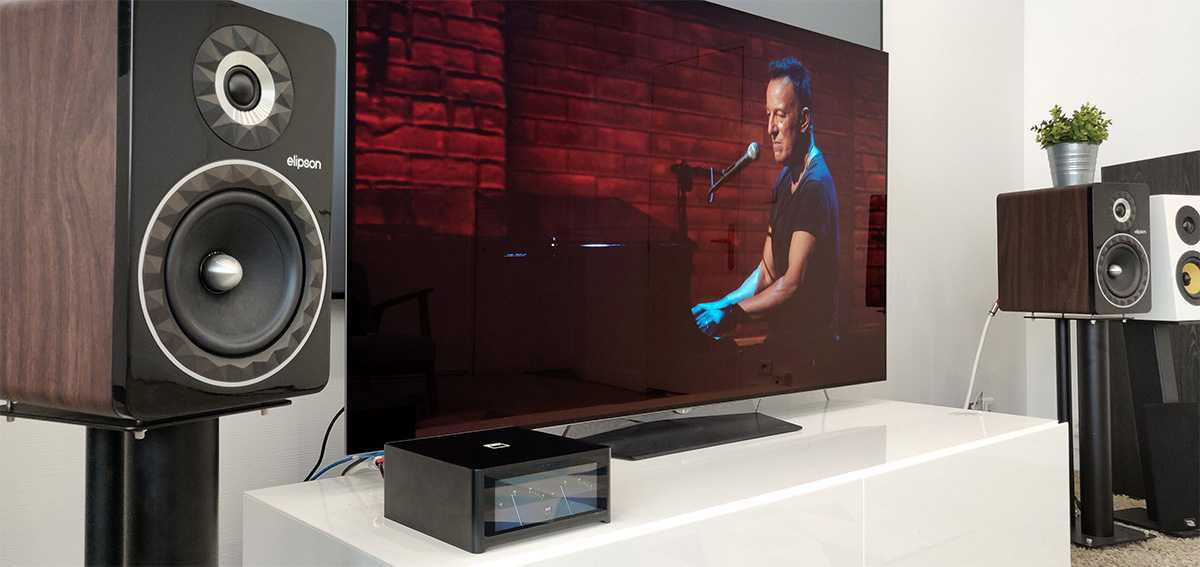
The NAD M10 amp paired with the Elipson Prestige Facet 8B compact speakers.
NAD Masters M10 features – A comprehensive specification
- Analogue and digital inputs
- Supports music streaming services
- BluOS brings multi-room into the equation
The whole point of the M10 is to offer as many options as is realistically possible – so, naturally enough, “Features” is a fairly long and comprehensive list. Best strap yourself in.
Amplification is rated at 100 watts per channel, and is provided by NAD’s “Hypex nCore” variation on the Class D standard. In theory, it provides all of the efficiencies of Class D but with none of the associated noise and distortion drawbacks. It’s a patented idea and has been implemented in several Masters Series products before now to great effect.
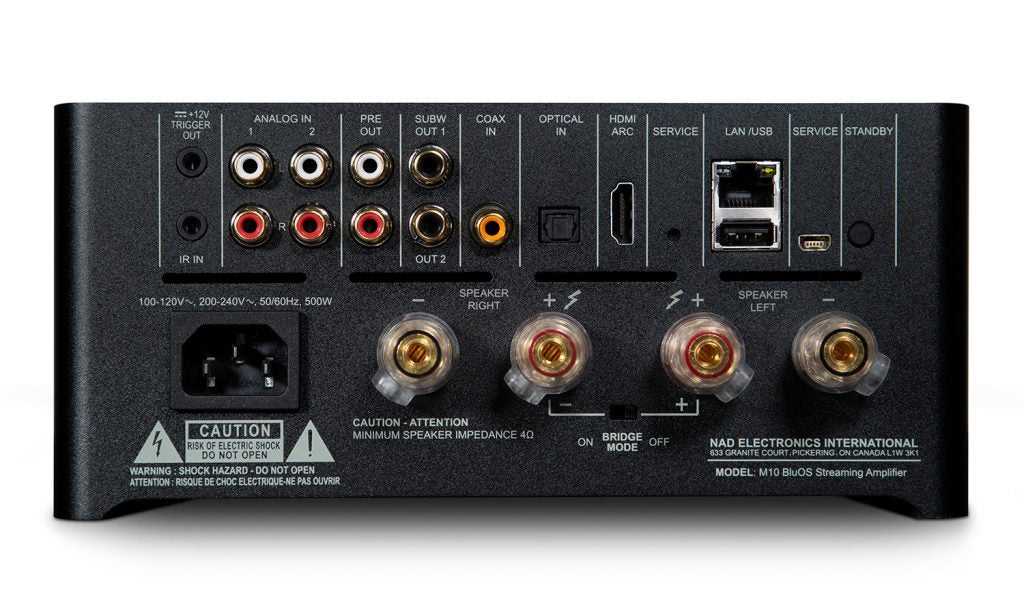
Access to this power is via two stereo RCA analogue inputs, a digital coaxial input, a digital optical input, an eARC-enabled HDMI input, Ethernet or Wi-Fi, and aptX HD Bluetooth. NFC pairing is available for Bluetooth connectivity, and the M10 can act as both a receiver and a transmitter, allowing for the use of Bluetooth headphones. Just as well, since there’s no physical headphone connection.
Outputs extend as far as binding posts for a single pair of speakers, stereo RCA pre-outs for use with a power amplifier, and not one but two pre-outputs for subwoofers – which is good news for bass-heads. There are also connections for IR relays and 12v triggers, so the M10 can be integrated into a custom-install system without problems.
Naturally enough, the M10 supports quite a number of music streaming services via the increasingly widespread BluOS operating system. In terms of the most popular, Spotify, Amazon Music and Deezer all feature, while the more discerning will be pleased to find Tidal and Qobuz among the many others available.
Internet radio is available via TuneIn and Radio Paradise with other, more esoteric, services also on board. BluOS is also happy to deal with any MQA audio files on your local network (or via Tidal Masters) as well as DSD and the more common FLAC, WAV and less attractive MP3 and AAC.
In addition, BluOS opens up the M10 to the wide world of multiroom. Given that BluOS is running a whole host of very well-regarded Bluesound products, and quite a few by DALI as well, building a high-quality, high-resolution multiroom system will only be restricted by your available budget.
All of these digital services and inputs are dealt with by an extremely capable 32bit/384kHz ESS Sabre 9028 DAC. In terms of noise levels, jitter negation and outright precision, this is as impressive a convertor as consumer technology has ever come into contact with.
NAD M10: connections
The NAD M10 is fitted with two line inputs (stereo RCA), a coaxial digital audio input and an optical digital audio input, a USB Type A port (to connect the calibration microphone and to read audio files stored on a flashdrive), as well as an HDMI input. The latter allows you to retrieve sound from a television whose audio output has been configured to send audio signals in PCM format. The NAD M10’s DAC can’t decode the Dolby Digital Plus codec used for DTTV and services such as Netflix and Amazon Prime Video. The NAD M10 connected amplifier also has two subwoofer outputs for amplified subwoofers and features a preamp output which can be used to connect a power amp.

The NAD M10’s connections are exhaustive and allow you to connect digital and analog sources, including a TV via the HDMI ARC input.
NAD M10: BluOS
The NAD M10 amp uses the BluOS software interface, which is also used by BlueSound devices. To control the amp remotely, the BluOS mobile app for Android and iOS can be downloaded for free from Google Play and the App Store. This app also handles multi-room audio, if you own several compatible NAD or BlueSound multi-room devices. Note that the NAD M10 amp is also Apple AirPlay 2 compatible, which means it can be added to a multi-room installation that uses this protocol.
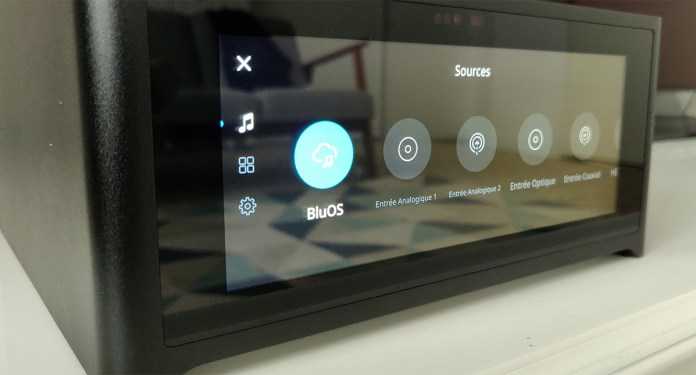
The NAD M10’s BluOS interface allows the amp to be controlled via a dedicated app and integrated into a compatible multi-room system.
NAD M10: design
- L’interface BluOS du NAD M10 permet de le contrôler depuis l’application dédiée et de l’intégrer dans un système audio multiroom compatible.
- L’ampli connecté NAD M10 possède un grand écran tactile en façade.
- La connectique du NAD M10 est très complète et permet d’y relier des sources numériques et analogiques, y compris une TV via la prise HDMI ARC.
The NAD M10 connected amplifier is in line with the current trend of compact digital amps boasting an elegant design. The modest dimensions of the chassis (215 x 100 x 260mm) mean it can be placed on even a small hi-fi or TV cabinet. The care brought to the build quality and the matte finish (on the sides) make it a very pleasant object to look at. The illuminated logo on top of the box and the transparent strips on the left and right that reveal the radiator heatsinks are a nice touch that add a little fun to the design. Lastly, the front of the amp is almost completely covered by a large, highly responsive color touchscreen. The screen displays the album artwork and the title of the song being played, and can also be used to control the main functions of the NAD M10.
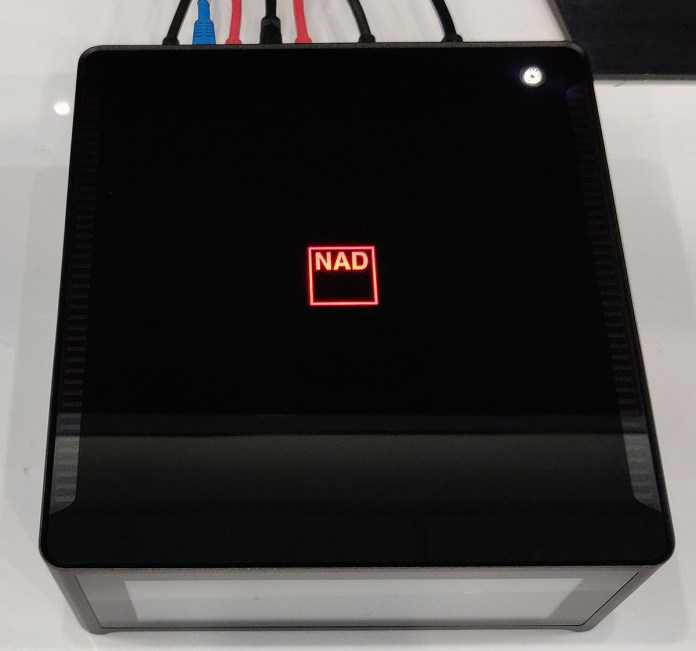
When the device is turned on, the NAD logo on top of the amp lights up in red before turning white. The heatsinks of the radiators are visible thanks to transparent strips on each side.
Мал, да удал
Вторая версия оснащена усилением аудиофильского уровня и ЦАПом со встроенными источниками для стриминга и широкими коммутационными возможностями. Благодаря улучшенному 7-дюймовому цветному сенсорному экрану IPS M10 v2 обеспечивает более чистые цвета и более широкий угол обзора, чем его предшественник. Технология усиления nCore с мощностью 100 Вт на канал скрывается за дисплеем, который одновременно является интуитивно понятным сенсорным контроллером уровня громкости, источников и других элементов управления звуком. Обновленные алгоритмы усиления M10 V2 обеспечивают более высокие уровни выходного сигнала при работе с низкочувствительными драйверами. Повышенный коэффициент усиления также доступен на выходах для сабвуферов, что позволяет использовать более широкий диапазон комбинаций «сабвуфер + основная акустика». ЦАП от ESS легко обрабатывает аудиопотоки BluOS до 24 бит/192 кГц и поддерживает «lossless» форматы.
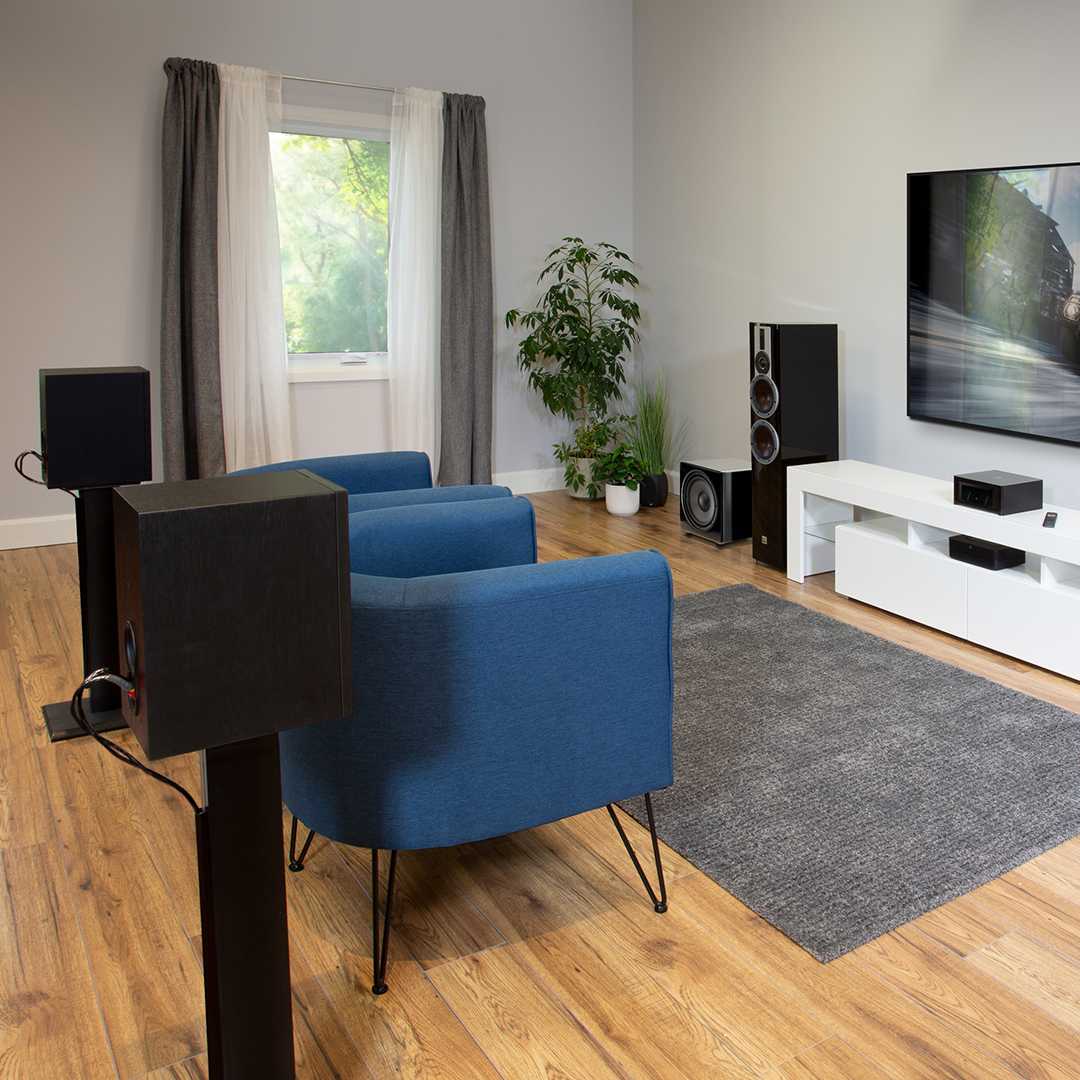
NAD Masters M10 design – Compact size
- Use Gorilla glass for top/front display
- High-res TFT touchscreen
- Good build quality
At H10 x W22 x D26cm, the M10 is usefully compact – it will occupy just half of a standard hi-fi rack shelf. And as a piece of design it’s more thoughtful than the functional majority of such products. The finely brushed, smoothly curved aluminium that forms the four vertical sides of the box is a single piece, while the top panel and front display cover are Gorilla glass. The “NAD” logo on top glows white during operation (or red, if all is not well).
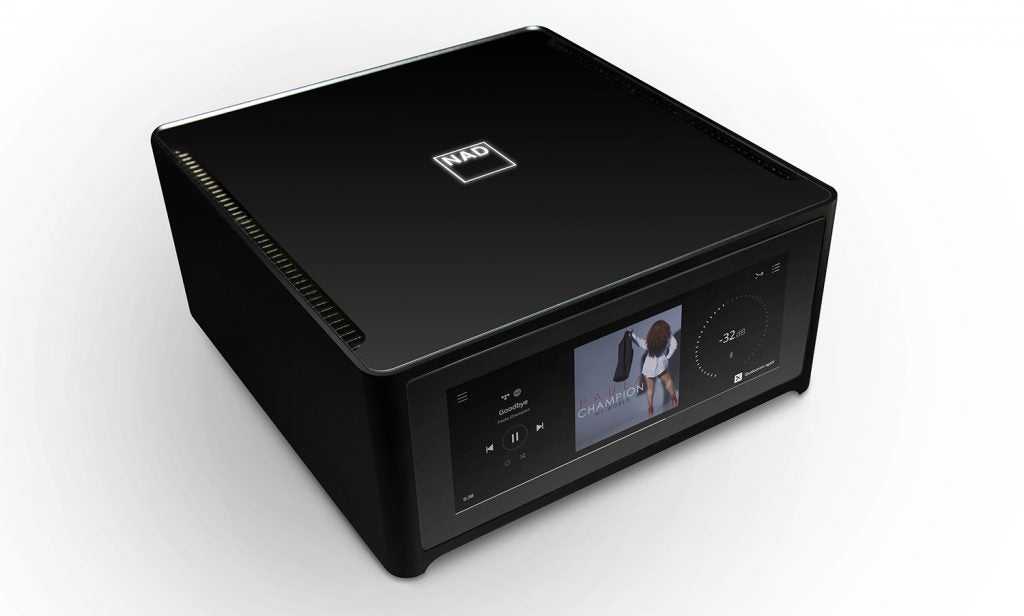
The display is a high-resolution TFT touchscreen, with plenty of options for customisation of input name, icon and so on. When streaming music wirelessly, for example, it serves up a bright representation of the album artwork and, even more gratifyingly, left/right VU meters from other inputs, if you so desire. Ask your Dad about VU meters and watch him get all misty-eyed.
NAD products have always made a decent design statement, with even the battleship-grey finish of its legendary back-catalogue of products was intriguingly individual. And with the M10 NAD has turned out a box that is of obviously high perceived value yet doesn’t do anything so gauche as shout about it.
Features
(Image credit: NAD)
Given that the Masters M10 can be operated without touching the device itself, you might assume that it comes with a smart remote. Alas, that’s not the case: the NAD relies entirely on app operation.
NAD Masters M10 tech specs
(Image credit: NAD)
Power output 2x 100W
Chromecast No
AirPlay Yes
Inputs RCA x2, HDMI, optical, coaxial, USB, Bluetooth
Outputs Subwoofer x2
Ethernet Yes
Wi-fi Yes
Dimensions (hwd) 10 x 21.5 x 26cm
For some, that could be off-putting, but the NAD Masters M10 is part of the BluOS ecosystem and so boasts a better, more widely supported and more reliable app than most. AirPlay 2 integration means that the M10 also appears as a destination device in the iOS apps of streaming services such as Tidal and Qobuz (Spotify Connect is also on board). If you still want a traditional remote control, you can teach the unit to respond to specific commands sent by a universal remote.
BluOS also brings with it the opportunity for the M10 to form part of a multi-room system comprising a mix of NAD, Bluesound and Dali devices, and ensures direct access to more music services than you’re likely to need, from Tidal, Qobuz and Spotify, to Deezer and Amazon Music (including Amazon Music HD). Roon is also supported, as are a number of smart home standards, and you can access music stored on computers and NAS devices on your own network.
High-resolution audio streams up to 32-bit/192kHz are supported, and formats including MQA, FLAC, WAV and AIFF are on board. It is possible to listen to DSD files, too, but only when converted via the BluOS desktop app.
Once you get the M10 home, simply connect a pair of speakers to start listening, although you can also use the integrated Dirac room equalisation software and bundled microphone to calibrate the sonic performance to your room. It is worth going through the process and deciding whether the calibrated or ‘raw’ delivery suits you best.
But just because the Masters M10 can be treated as an all-in-one player doesn’t mean it has to. Thanks to its abundant connections, it can also form the hub of a complete system There are two pairs of stereo analogue inputs for a CD player or turntable (there’s no integrated phono stage), coaxial and optical digital connections, and even an HDMI socket with full eARC (Enhanced Audio Return Channel) support so that your TV can be hooked up.
(Image credit: NAD)
There’s ethernet for wired networking, plus a pair of pre-outs and two subwoofer outputs, below which sit two pairs of standard speaker terminals. Our only disappointments on the connections front are that the single USB socket is on the rear (a more accessible one on the front or side might be nice) and the lack of a headphone socket.
NAD addresses the latter with two-way aptX HD Bluetooth (you can send music from the NAD to your Bluetooth headphones as well as send music to it from your portable device), but those with a cherished pair of wired headphones will be disappointed.
At the heart of the system is NAD’s HybridDigital amplification, which is designed to deliver more accurate, distortion-free and dynamic sound. NAD conservatively rates power at 100W, but claims that dynamic power can reach 160W into 8 ohms or 300W into 4 ohms. In other words, there should be lots of headroom for epic dynamic shifts.
Универсальный дизайн
M10 V2 оснащен прочным корпусом из матового алюминия и чёрными панелями из стекла Gorilla Glass. Минималистичный дизайн позволяет вписаться в жилое пространство, а с добавлением рум-коррекции Dirac Live любая комната может достичь акустического совершенства. Прилагаемый калибровочный микрофон позволяет измерять реверберации и другие «аномалии», корректируя пики и провалы в низкочастотном спектре до 500 Гц (профессиональная полнодиапазонная версия Dirac доступна за отдельную плату). Для удобства есть возможность сохранения до пяти профилей калибровки для разных точек прослушивания.
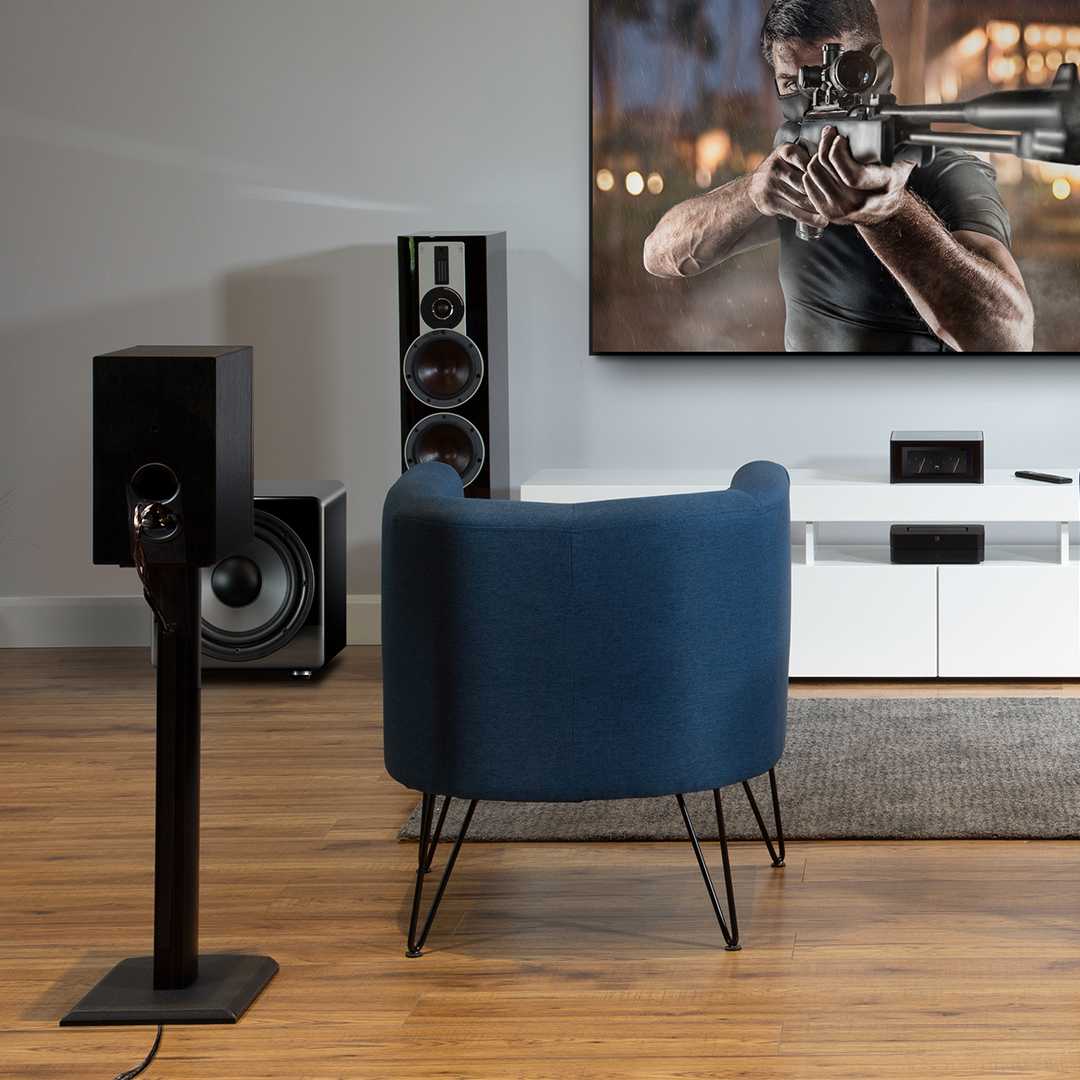
NAD M10 + Davis Acoustics Courbet N°3
More compact than the Elipson, The Davis Acoustics Courbet N°3 speaker features a mid-bass driver that is only 5” in diameter. This is reflected in the sound with lows that are dynamic but not as deep or powerful as those provided by the Prestige Facet 8B. That said, the restitution is pleasant, with a good amount of detail, convincing spatialization and a nice presence.
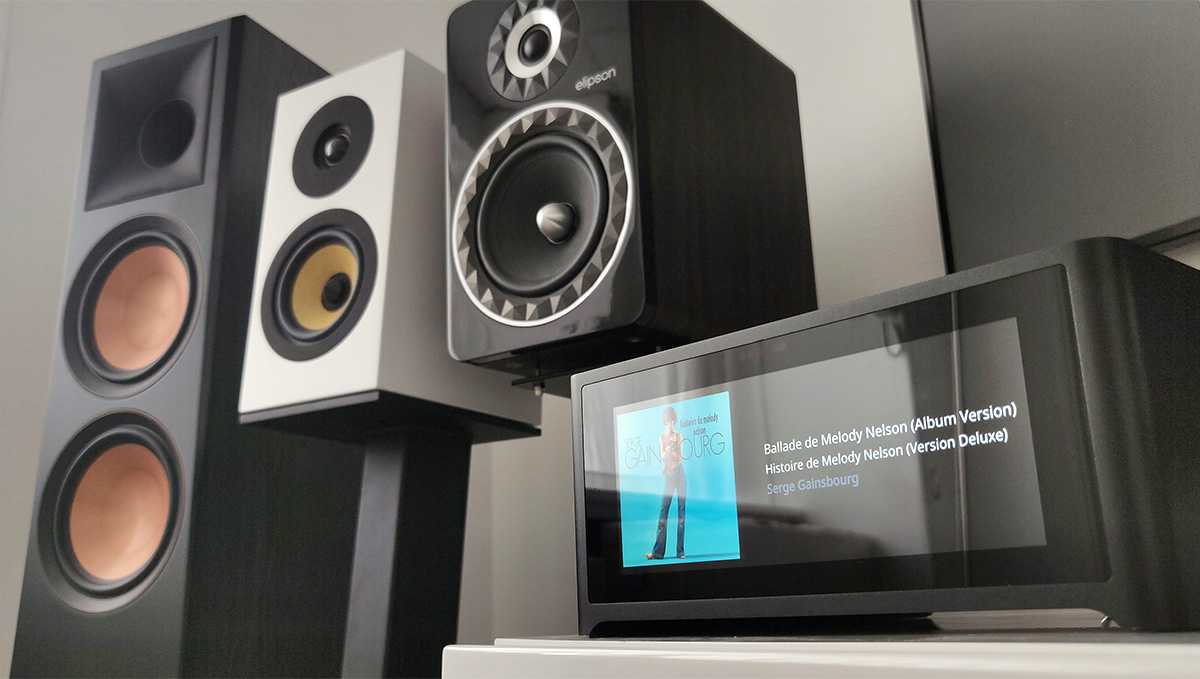
The NAD M10 connected amplifier with the Elipson Prestige Facet 8B speakers, the Davis Acoustics Courbet N°3 speakers and the Klipsch RP-8000F speakers.
We thoroughly enjoyed listening to Melody Gardot’s Live in Europe on Qobuz, especially the song Baby I’m A Fool (Live in London, 24-bit/44.1kHz). However, the speakers could benefit from being associated with a subwoofer to balance things out, using the NAD M10’s two subwoofer outputs. Note that the BluOS app allows you to indicate the presence of a subwoofer and configure the crossover frequency, from 40Hz to 200Hz.
NAD M10 + Elipson Prestige Facet 8B
The Elipson Prestige Facet 8B compact speakers are relatively easy to drive thanks to their high sensitivity rating. Their nominal impedance of 6 Ohms does not cause any problems for the NAD M10, whose power reserve is tailored for much more demanding speakers.
The neutrality of this NAD amp goes well with the fullness of the Elipson speakers, which in this instance is slightly attenuated without the speakers losing any of their character. Therefore, the restitution is both natural and warm. The lows are generous, dense, and very lively. The NAD M10 handles the highly responsive 6 inch drivers of this gorgeous French speaker with confidence. The highs are lofty, transparent, and delicately outlined. The mids are pleasantly textured, and the vocals are beautifully rendered.
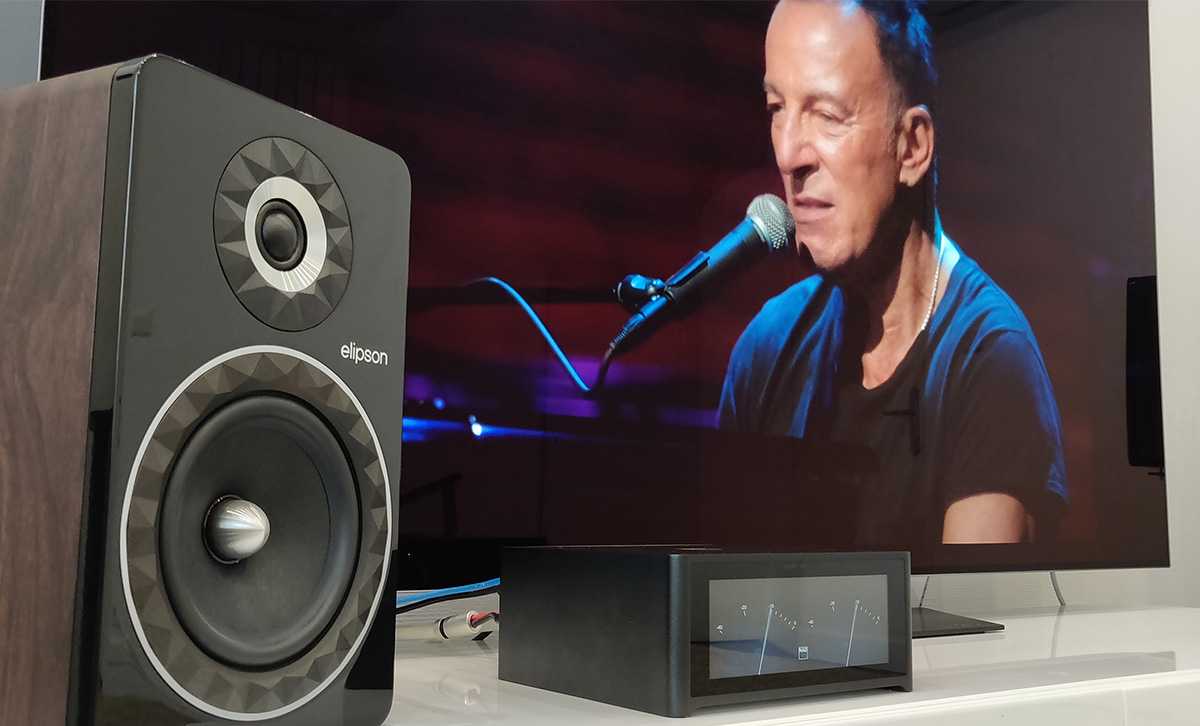
Paired with the Elipson Prestige Facet 8B speakers, the NAD M10 amp won us over.
The combination proved to be both very smooth and pleasantly dynamic. The attacks are bold, and the lows have a lot of punch if needed, but the NAD M10 also knows how to be subtle and refined. With Tracy Chapman’s The Love That You Had (Qobuz, CD quality, 16 bits/44.1kHz), the lows are nicely extended, the kick drum is vigorous but the drummer’s cymbal work remains delicate and subtle. The bassline extends energetically without being overpowering, cleverly highlighting the guitar and vocals. The soundstage is wide, deep and expertly layered: the instruments and the artist are easily located and seem to be physically present in the room.
Build
(Image credit: NAD)
The NAD Master M10 is similar in dimensions to its Naim rival. It’s a compact unit, 10cm tall and 26cm wide, and can be housed almost anywhere – although it’s advisable to make sure it’s facing the listening position as much as possible, so that you can take full advantage of the excellent display.
That TFT screen takes up the majority of the front panel and has the resolution and colour balance to display album artwork and combine that with big, bold text that’s easy to read from across the room. Should you choose to interact with it directly (there’s no need to touch the M10, once installed), the screen is responsive and the touchscreen volume dial’s audible click makes it quite tactile.
It’s a bigger and more useful screen than that of the Naim Uniti Atom, but in terms of its general build, the Atom is streets ahead. The NAD’s casework is rather insubstantial and doesn’t match the expectations set by a product at this sort of money. Still, you will rarely need to touch the device, and from across the room, the clear screen looks smart.
Sound
(Image credit: NAD)
We kick off with Childish Gambino’s incendiary This Is America and are pleased with what we hear from the NAD. It works well in terms of tone, with no part of the frequency range sticking out or drowning out another. The threatening bass is lusciously deep and dramatic, the high hat-like synth is nicely controlled. Vocals emerge clearly even when the soundstage gets busy.
We notice some muddling during the busy sections, though, and while it may at first seem as if that’s the track’s intention, a switch to the Naim Uniti Atom proves that this is actually a carefully coordinated construction by rhythmically placing each sound more accurately and giving everything more space to breathe in a broader, deeper soundstage. The NAD sounds pleasant, likeable and fluid, but the Naim simply tightens everything up.
Switching to The First Big Weekend by Arab Strap, the NAD proves to be a detailed performer, digging up the creak of the seat right at the start of the track and every intake of breath in the spoken vocal. There’s lots of solid punch to the kick drum, too, particularly once the volume is cranked over halfway.
(Image credit: NAD)
When the high-hat is added and the tempo increases, the NAD struggles a touch to keep up. It sounds as though it’s chasing the track rather than driving it. Though the vocal is still fairly clear and focused, the NAD becomes a bit muddled again, losing track of the individual strands in play.
We change pace with the stripped-back folk version of Here’s The Tender Coming by The Unthanks. The NAD doesn’t have a large ensemble to worry about and the performance delivered is detailed, smooth and clean. Listened to in isolation, it is hard to fault – especially considering the all-in-one nature of the device.
But again, the Naim takes things further by revelling in the low-level dynamics in the vocals and gentle instrumental accompaniment. The NAD’s delivery drifts over you, while the Naim’s is more sorrowful, entrancing and poignant.
NAD M10: 32-bit DAC, Deezer, Qobuz, Spotify
Decoding digital audio files is handled by an ESS Sabre 32-bit/384kHz DAC that supports MP3, AAC, WMA, OGG, WMA-L, ALAC and OPUS formats, as well as the hi-res audio formats MQA, DSD, FLAC, WAV and AIFF stored on a USB stick or shared via the home network. Simply connect the NAD M10 to the home network (with an Ethernet cable or via WiFi) to access music stored and shared (DLNA protocol) on a NAS or computer, as well as many online music services such as Deezer, Qobuz, Spotify and Tidal, amongst others, but also webradios, in particular via TuneIn. It is unfortunate that there isn’t a USB Type B port to use the NAD M10 as a DAC connected directly to a computer.
EXCLUSIONS AND WARRANTIES
The software and documentation are provided “AS IS” and without warranty of any kind and NAD expressly disclaims all other warranties, express or implied. NAD will not be liable for damages, either direct or consequential, arising from the use of this product or from the inability to use this product, even if we have been informed in advance of the possibility of such damages. While we have made every effort to ensure that the Upgrade Software and/or Program, or Documentation operates in the manner described, we do not guarantee operation to be error free. Upgrades, modifications, or repairs to this program or documentation will be strictly at the discretion of NAD. If you encounter problems installing or operating the Upgrade Software and/or Program, or following the Documentation, please contact NAD Electronics at support@nadelectronics.com
Because of the great variety of PC-compatible, operating system versions, and peripherals currently in use, we do not guarantee that you will be able to use Upgrade Software and/or Program successfully on all such systems.
NAD M10: BluOS app
Once we unboxed the NAD M10 amp, we connected it to the home network with an Ethernet cable hooked up to one of the network inputs of our Netgear Orbi RBK50 pack’s satellite.
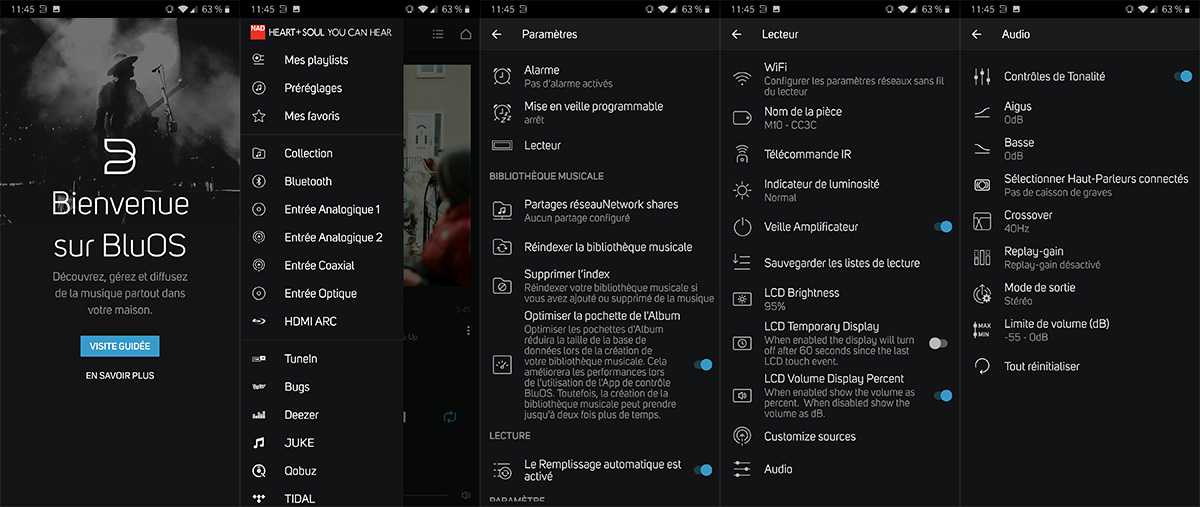
The BluOS app allows you to set up network sharing to read files stored on a NAS, access WiFi settings, change the luminosity of the screen, or even modify the crossover frequency if you are using a subwoofer…
Next, we launched the BluOS app on our Android smartphone which was connected to the same network and the app quickly detected the amplifier. This app is necessary to configure the NAD M10, adjust different settings and access online music services and webradios. Consequently, we were able to access our Deezer and Qobuz accounts to listen to our playlists.
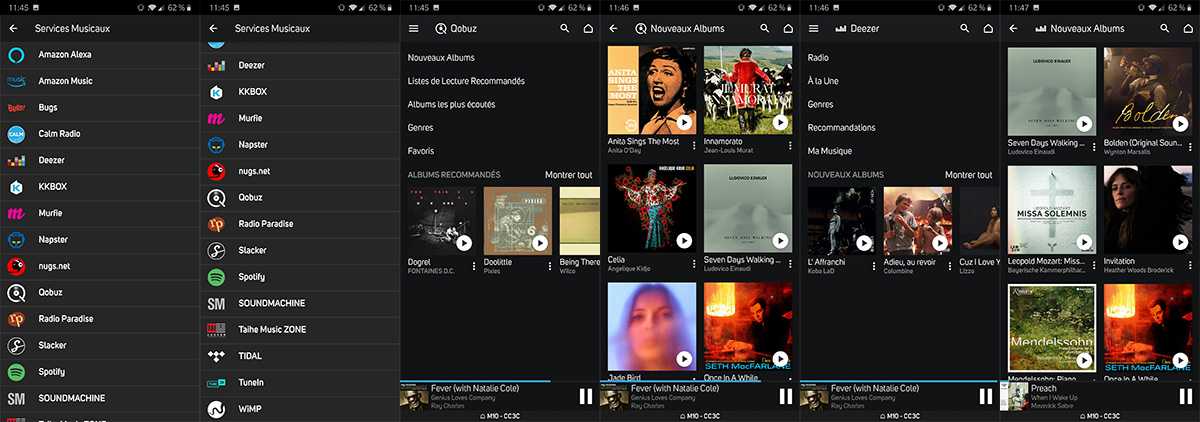
The BluOS application lets you log in to numerous online music services. Its intuitive interface provides access to new releases, recommended songs and albums, as well as your favorite playlists and tracks.
Amongst the handy functions offered by the BluOS app, we really appreciated being able to create a shortcut for our favorite radios and playlists. With the shortcut, they can be accessed directly on the NAD M10’s touchscreen, without launching the app on a smartphone.
A few settings are also available via the interface of the NAD M10, such as the auto sleep function, the tone settings and the screen luminosity settings.
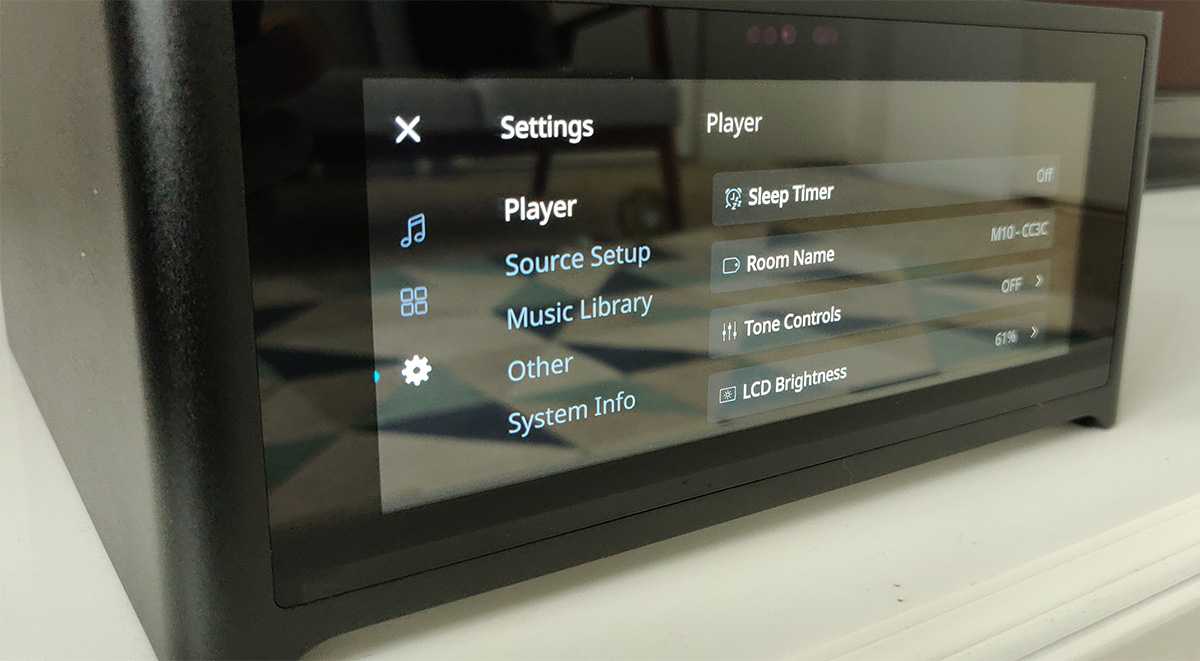
The NAD M10’s menu grants access to several functions and settings.
For this review, most of our listening sessions were carried out using our reference compact speakers, the Elipson Prestige Facet 8Bs, and the Viard Audio Silver HD12 HP speaker cables mounted with banana plugs. We also paired the amp with the Davis Acoustics Courbet N°3 compact speakers, as well as the Klipsch RP-8000F floorstanding speakers.
Современный Hi-Fi
NAD Masters M10 V2 воплощает в себе все основные идеи Hi-Fi для современного слушателя. С помощью удобного русифицированного приложения BluOS можно воспроизводить музыку из потоковых сервисов и локальных источников. Возможности для коммутации M10 V2 действительно впечатляют: аналоговые, оптические и коаксиальные входы, HDMI eARC и USB-A для подключения проигрывателей компакт-дисков, игровых консолей, внешних накопителей, медиаприставок, ТВ и других компонентов. Наличие двустороннего aptX HD Bluetooth добавляет универсальности новому M10. Пользователи также могут направить аудиосигнал на различные устройства: стерео и кинотеатральные акустические системы, беспроводные наушники и BluOS-плееры в кол-ве до 63-х.
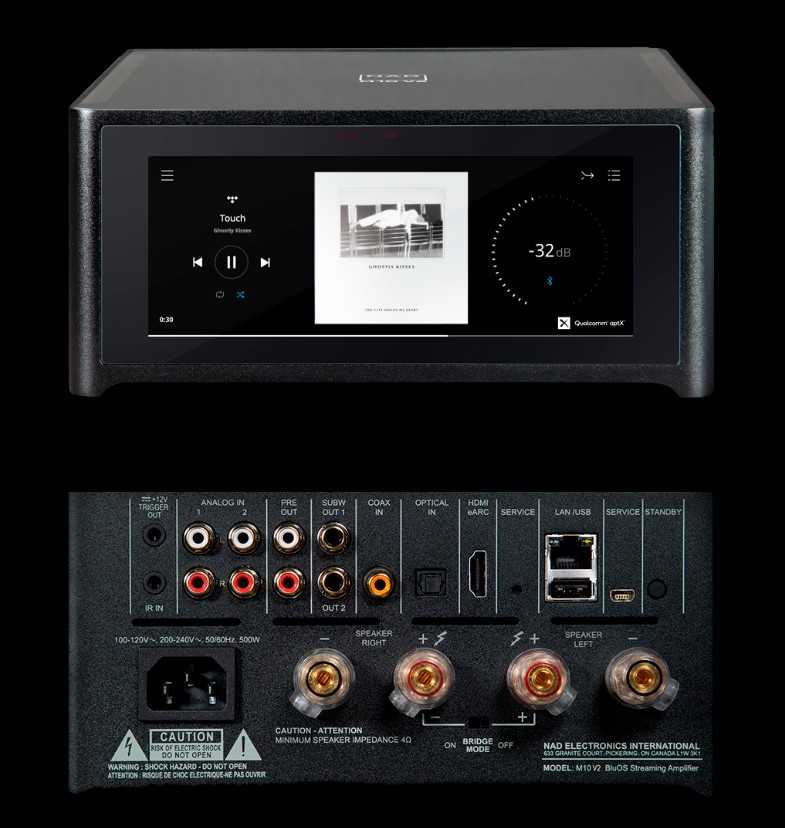
NAD Masters M10 interface – BluOS app not always the most stable
- Useful touchscreen
- BluOS app offers further control
- Support for Dirac Live room-correction
There are a number of ways to get what you want from the NAD M10. There’s that lovely, bright and detailed touchscreen, for a start. It’s reasonably responsive, extremely clear and simple enough to operate.
But there’s something very last century about getting out of your chair to manually operate your equipment – and the NAD’s display is plenty big and bright enough to be legible from across the room. So, in theory, it’s far better to use the BluOS app (iOS and Android) to issue your commands. In practice that’s true, almost all of the time.
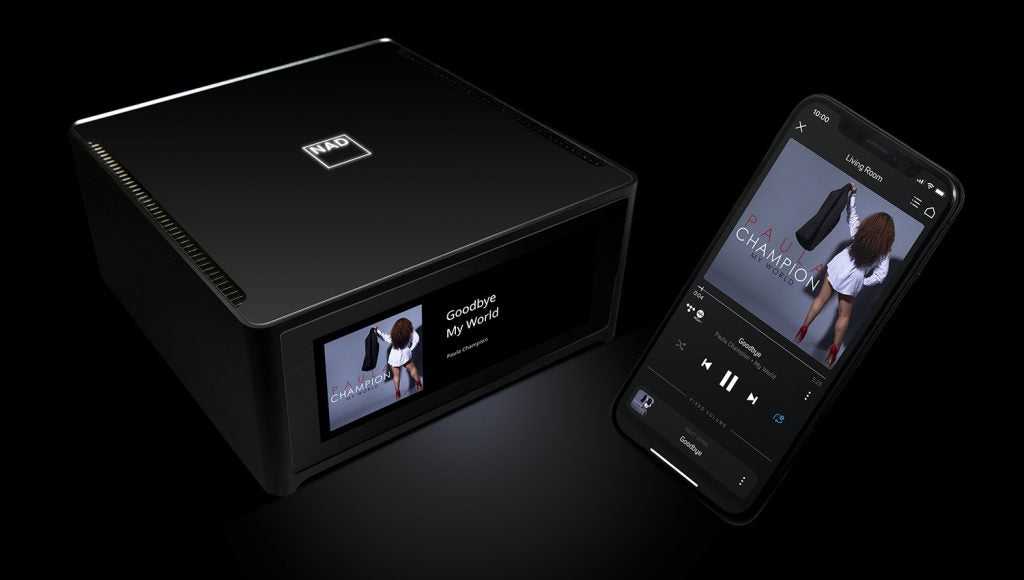
I’ve had run-ins with the BluOS app before now. The problem with control apps, especially when they’re operating equipment as expensive and high-performance as this, is that if they don’t function perfectly, 100% of the time, it tends to cheapen the whole experience. And the problem with the BluOS app is that it functions perfectly almost all of the time. So when it doesn’t, it’s annoying and/or disappointing.
Switching between inputs – specifically between physical and streaming inputs – can flummox the BluOS app. Not every time – but often enough that you can’t ever quite relax fully; but not so often that you’d give up entirely and demand a refund.
For example: having renamed the digital optical input as “CD Player”, I am happily listening to a CD when the urge to listen to something different on Spotify takes me. So I use the BluOS app to switch inputs and select some music on Spotify. Most of the time this works exactly as it should. Every now and then, however, it freezes when switching to “Music Services”. Not often, like I say – just often enough to keep you on your toes. It’s disproportionately infuriating.
If you have an Amazon Echo device, the BluOS voice skill in the Alexa app will allow you to issue straightforward voice commands, and once AirPlay 2 is integrated (which won’t be long) Siri will be available too.
Setup is further aided by the inclusion of Dirac Live room-correction technology. Using the bundled microphone, Dirac Live can analyse both your speakers and your listening space in order to optimise the NAD’s performance. It’s operated by another truculent app, but at least it needs doing only once – and is pretty effective.
OTHER
You acknowledge that NAD owns all right, title and interest, including but not limited to all copyrights, trade secrets, and other intellectual property in and to the programs and accompanying documentation.
YOU ACKNOWLEDGE THAT YOU HAVE READ THIS AGREEMENT, UNDERSTAND IT AND AGREE TO BE BOUND BY IT. YOU FURTHER AGREE THAT IT IS THE COMPLETE AND EXCLUSIVE STATEMENT OF AGREEMENT BETWEEN YOU AND NAD CONCERNING THE PROGRAM AND ACCOMPANYING DOCUMENTATION AND THAT IT SUPERSEDES ANY DEMONSTRATION, ADVERTISEMENT, PROPOSAL OR PRIOR AGREEMENT, ORAL OR WRITTEN BETWEEN YOU AND NAD OR BETWEEN YOU AND ANY OTHER PARTY RELATING TO THE UPGRADE SOFTWARE AND/OR PROGRAM, AND ONLINE DOCUMENTATION.
Please indicate your acceptance by pressing the I Agree button below.
NAD Masters M10 sound quality – Thoroughly impressive
- Fine detail and character
- Controlled bass
- Short of outright attack
Using Tidal via the BluOS app to listen to an MQA stream of The Smiths’ “The Queen Is Dead” quickly makes all the low-temperature grumbling about app stability almost irrelevant. The NAD delivers the masterpiece of 80s indie with the sort of instinctive correctness that could bring a lump to the throat of even the hardest-hearted listener.
In terms of timing, the M10 knits the guitar/bass/drums/keyboards strands together in an entirely believable, natural way – the sense of interaction in the rhythm section, in particular, is almost tangible. Tempos, even those as gimpy as that of “Never Had No One Ever”, are handled deftly.
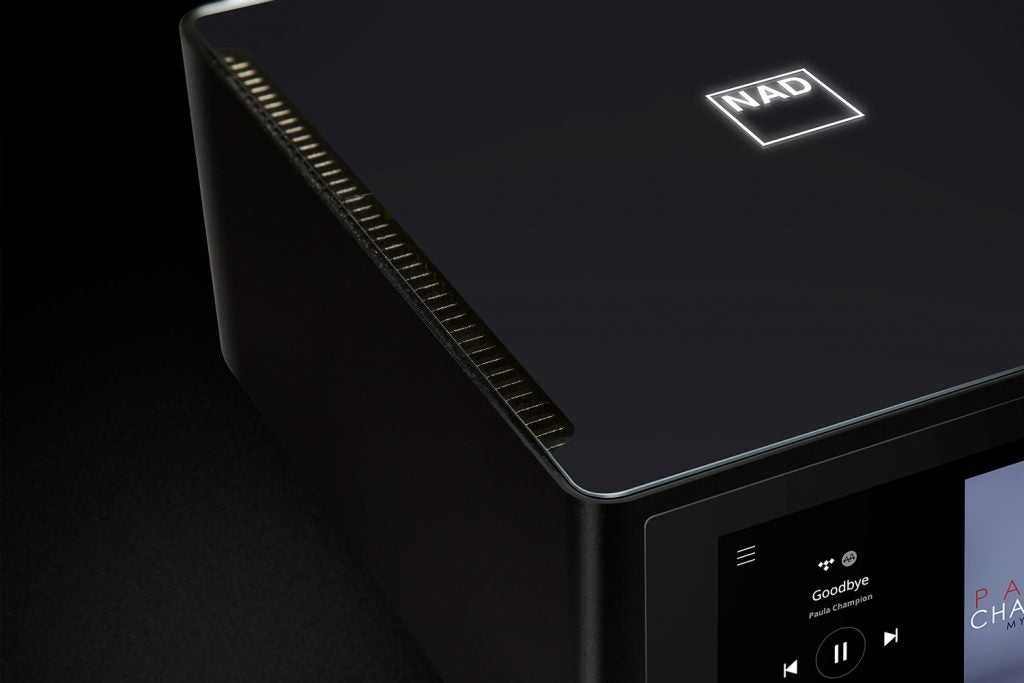
The M10 doesn’t scrimp on the details, either. The sound of the guitar during those weightless few seconds in the middle of “Bigmouth Strikes Again” is as much about the sound of plastic plectrum on metal strings as it is about the resulting tone – and throughout the album, the NAD lays the finest details bare. Morrissey may not be in possession of the world’s finest singing voice, but he’s a vocalist loaded with character, and the M10’s mid-range reproduction allows all his self-knowing self-regard full articulacy.
A 24bit/96kHz download of Daniel Hope’s “For Seasons” via the local network gives a great explanation of the M10’s way with tone and timbre. Hope’s violin bites, weeps and grinds with great expressiveness, and the NAD is there every step of the way. Hope is a lyrical player, not above a bit of crowd-pleasing (his arrangement of Aphex Twin’s “Avril 14th” is a fine case in point) and the NAD is brilliantly communicative of his intentions.
A switch to a CD copy of The Flaming Lips’ “The Soft Bulletin” (actually an HDCD – again, ask your Dad) reveals some remarkable bass fidelity, too. There are some earth-movingly deep notes during “Waitin’ For A Superman” that even some very capable, hugely costly systems overlook; but not the NAD. It has startling low-frequency presence, but it’s no show-off. Bass is textured, controlled and, above all, rapid. In this respect alone, the NAD has the better of plenty of more expensive rivals.
The whole of the frequency range is delivered judiciously, in fact. “Looped” by Kiasmos (via Spotify this time) has some clattering percussion that can be problematic, but the NAD holds everything in check without rounding anything off.
And no matter the music you’re playing, or the source from which you’re playing it, the M10 treads an impressive line between control and engagement. It isn’t the most visceral, up-and-at-’em presentation you’ve ever heard, but neither is it especially matter-of-fact. If the idea of “good taste” in music reproduction doesn’t appeal, you might conceivably find the M10 a little polite – but the rest of us will just admire its even-handedness.
In fact, it’s only where out-and-out dynamism is concerned that the M10 is anything less than thoroughly impressive. A vinyl copy of Kamasi Washington’s “The Epic” (delivered via a Leema phono stage) enjoys all the detail, and all the organisational and tonal dexterity, discussed above – but the NAD’s relative shortage of outright attack makes “Clair De Lune” sound just slightly tentative. When the instruments are massing and the vocal chorus is chipping in, too, the impression should be one of momentum – but the M10 seems just slightly reluctant to let it all off the leash.
LICENSE
Under this Agreement NAD grants you a non-exclusive, non-transferable, non-sublicenseable, royalty-free limited license to use the program or online documentation for use solely for the purpose of upgrading NAD Products.
YOU AGREE NOT TO MODIFY, ADAPT, TRANSLATE, REVERSE ENGINEER, DECOMPILE, OR DISASSEMBLE THE PROGRAM OR ONLINE DOCUMENTATION, IN WHOLE OR IN PART, EXCEPT AS EXPRESSLY PROVIDED FOR IN THIS AGREEMENT OR UPON NAD’S WRITTEN REQUEST. IN ADDITION YOU AGREE NOT TO TRANSFER OR DISCLOSE THE PROGRAM, ONLINE DOCUMENTATION OR ANY PROGRAM YOU DEVELOP FROM THEM IN WHOLE OR IN PART, TO ANY THIRD PARTY EXCEPT UPON NAD’S PRIOR WRITTEN APPROVAL. FINALLY YOU AGREE NOT TO USE THE PROGRAM IN WHOLE OR IN PART FOR ANY PURPOSE OTHER THAN AS OUTLINED IN THE ONLINE DOCUMENTATION.
This license is effective until terminated. You may terminate it at any time by giving NAD written notice to that effect. NAD may terminate it if you fail to comply with this Agreement by giving you notice. Upon termination you will destroy the program or documentation and all copies you have made of them. In addition upon termination you will have no recourse against NAD for your inability to use the program or accompanying documentation.
Просто добавьте…ещё больше акустики
На коммутационной панели M10 v2 располагаются акустические клеммы аудиофильского класса, а также два независимых разъема для сабвуферов, выходной сигнал которых легко контролируется и настраивается с помощью приложения BluOS Controller. Поклонники домашнего кинотеатра теперь могут сформировать беспроводную систему объемного звучания Dolby Digital 4.0, 4.1 или 4.2, используя пару «сетевых» динамиков или усилителей с операционной системой BluOS. M10 v2 способен передавать данные к тыловым каналам по Wi-Fi в режиме «LOW LATENCY», что освобождает от необходимости использования проводного подключения.

